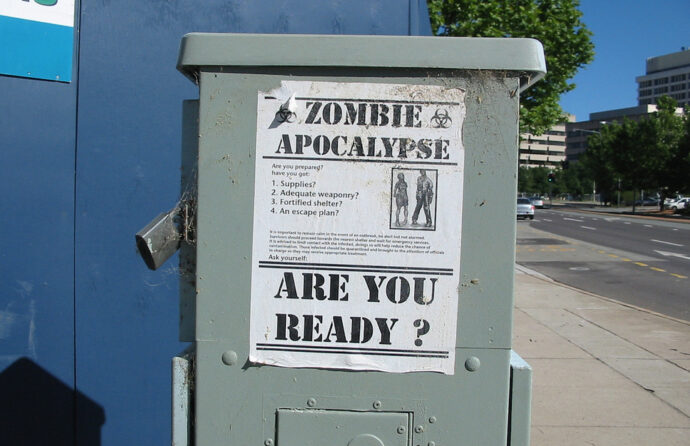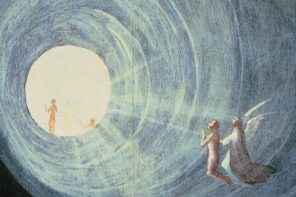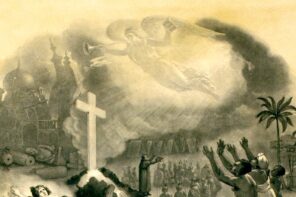This week, researchers at Cornell spent presumably valuable time determining the safest places to be during a zombie apocalypse. Key takeaway: not big cities.
To observe that the apocalypse, in varying forms, is all around us is no more than a platitude. Pick your apocalypse: zombie apocalypse, any number of post-apocalyptic worlds that crowd our television screens, movie theaters, and book stores, or, perhaps more traditionally, the apocalypse associated with the Second Coming. Think of the 2011 Family Radio Billboards: “He is Coming Again! May 21, 2011.” Or the tongue-in-cheek bumper sticker: Jesus is Coming, Look Busy.
During the last week of January 2015, police in Utah concluded their investigation of the September deaths the Strack family in Springville, Utah. An older son of Kristi Strack found his mother, along with Benjamin Strack and the couple’s three children, all dead. The announcement concluded that the parents’ deaths were suicides, and that the couple had killed the two youngest children. The way the eldest child died, a 14-year old boy named Benson, remains, according to the AP reports, “undetermined.”
Why would Benjamin and Kristi Strack kill themselves and their children? The short answer: a “pending apocalypse.”
But beyond that, no details. According to various reports, Kristi Strack had once been obsessed with Dan Lafferty, now imprisoned for his role in the murder of his sister-in-law Brenda. (Dan and his brother Ron belonged to a splinter group of fundamentalist Mormons who believed in polygamy, among other things, and Dan continues to identify as the prophet Elijah, who will herald the Second Coming of Jesus.) The Stracks and Dan Lafferty knew each other, but apparently, according to reporters Lafferty did not talk much about the impending end of the world with the Stracks and their contact ended in 2008.
Nothing in the Strack’s house (and nothing they said to their neighbors or friends or family, at least as far as has been revealed to the press thus far) indicates why the Stracks thought the apocalypse loomed near in September 2014. There has been no mention of fear of a terrorist attack or a nuclear attack, of Jesus’ return or the book of Revelation—just hints about wanting to “get off the grid,” as Deseret News reported.
Yet Benjamin and Kristi Strack thought the end was near—and it is hard to imagine that this was unconnected to the theology spouted by Lafferty.
Again, to say that the apocalypse, in varying forms, is all around us is no more than a platitude. Despite the commonplace nature of our fascination with The End, what seems run-of-the-mill becomes profoundly important when tragedies like the Strack family suicide strike. From heartrending suicide-murders prompted by the belief in the imminent end of the world to empty bank accounts and broken families following Harold Camping’s failed predictions of Jesus’ return to our cultural fixation with the shuffling creatures we call zombies, we won’t stop thinking about the end.
Alternatively, maybe we simply cannot. After all, throughout history the end of the world has always been near—despite the fact that the end has yet to happen. The dichotomy matters.
At the end of January, emails flooded my inbox with links to articles that detailed the story of the Strack family. I’m currently teaching a course called “From Revelation to ‘The Walking Dead’: Apocalypse Now and Then,” and earlier this semester I encouraged students to send me articles, videos, advertisements, movie trailers—anything that they that had to do with our topic: the end of the world, from ancient to contemporary conceptions.
In the light of the Stracks’ deaths, the name of my course seems flippant. It is, admittedly, a ploy to get students into the biblical studies classroom: there are no zombies in the Bible.
Nevertheless, zombies sell, as The Walking Dead‘s creator Robert Kirkman and others know well. The course stems from the knowledge that pop culture and monsters interest students, even if ancient biblical texts don’t (at least, not often and not at first). Yet it was also born out of a desire to show students that ancient texts matter, and that these texts continue to live on all around us, whether we know it or not. Sometimes these afterlives are beautiful and inspiring; sometimes these afterlives are awful, created out of fear and some two thousand years of failing (often) to ask the right questions about the text(s) we are reading.
I came to teaching zombies late in the game in the spring of 2014, when zombie courses had long been on the books at a number of institutions across the United States, in literature courses and sociology classes and beyond. Scholars like Kim Paffenroth and Kelly Baker, among others, had already firmly established the relevance and importance of studying zombies and other monsters within the field of religious studies more broadly.
Yet between the excellent work of CMU’s media team and the strange world of the internet where sometimes the AP picks up a story about a class being taught in the middle of Michigan, “From Revelation to ‘The Walking Dead’” briefly turned into my fifteen minutes of fame. Radio shows, newspapers, and television stations called to ask me for interviews.
While the media seemed intrigued, the overarching response form the public was quite different, boiling down to some formulation of “What you are doing is evil. Your students will never get jobs. There are no zombies in the Bible and Jesus is not pleased that you are teaching otherwise.”
However, the end of the world is always/never near—and it matters.
The reactions I received to a course that connected ancient and contemporary apocalypses underscored this. The level of vitriol in comment threads in on-line articles (I know, I know) highlighted ever more pressingly the reality that what we as scholars of the humanities and/or religious studies are trying to accomplish in the classroom is very different from what people think. Most critics assumed that I was teaching students “how to survive the zombie apocalypse.” (I will refer them, now, to the zombie team at Cornell.)
Others, because they saw the word “Revelation” in the title alongside a zombie reference, assumed I was teaching my students that there were zombies in the Bible. (There are no zombies in the Bible; the zombie is a creature that entered Western culture not through the ancient Near East or Europe, but through slavery, colonialism, and a profound Western misunderstanding of the Vodoun religion and Haitian culture.)
What I was trying to do was get my students to think. To make connections between our pasts and our present, to wonder why humans are not so different today than the were 2000+ years ago, and—most importantly—to provide an opportunity for students to improve the kind of skills that they would need when they graduated and entered the workforce. Very few of my students would go on to study either a) the Bible or b) zombies. Yet all of them would need to know how to work with others, to read and write carefully and with an eye toward genre and context, to understand the “Other,” that cultures share (and borrow or steal and adapt) ideas, and that history matters—all things I strived (successfully or not) to teach. After all, what happened to William Miller? Hal Lindsay? David Koresh? Harold Camping? Their followers?
Each tried to read the books of the Bible—including Revelation—in order to predict a coming apocalyptic end. Each—some of them multiple times—were wrong about their predictions. Part of the reason that these endless predictions were wrong was because they weren’t asking the right kind of questions about the literature they were reading. It’s like they had taken a copy of Harry Potter and the Sorcerer’s Stone into King’s Cross Station and were repeatedly ramming their faces into the brick wall that serves as the backdrop for the tourist trap that is Platform 9 ¾. Harry Potter and the Sorcerer’s Stone won’t get you to Hogwarts, but that doesn’t mean you can’t learn from reading it. Harry Potter taught an entire generation of kids (the ones who sit in my classrooms today) about the importance of loyalty, friendship, and studying for exams.
The book of Revelation—or any other apocalyptic text—is not a handbook to how the end times will unfold, but that does not mean apocalyptic literature does not matter. The end of the world is simultaneously always and never here. Type “mark of the Beast” into Google: just recently a man in West Virginia won a court case against the company he works for because he thought that the machine they were using to clock hours was the “mark of the Beast.” That he was wrong—and that the case proved he was wrong—mattered less than his “sincere beliefs” about the usability of the book of Revelation to interpret the present.
These stories are why it matters what we do in the religious studies classroom. Revelation is a looking glass into the world of the earliest Christians and what they desired, feared, and yearned for in their present context. Readers have continued to invoke the book of Revelation in meaningful ways throughout history and today without using it to try to figure out when the end will come. The final book of the New Testament does not have to reside upon a shelf as a dusty, useless relic, as only a failed prediction of the end of the Roman Empire. It can be a source of hope for the oppressed, as it was in apartheid Africa; a critique of imperialism and commercialism; a call to remember the impact that class and gender can and does have on power dynamics. The book is more than a Doomsday Clock.
Likewise, “that zombie crap you teach,” as one relative not-so-gently expressed his opinion of my course, matters. It matters because examining the monsters we fantasize about (zombies or otherwise), as scholars like Timothy Beal and Jeffrey Jerome Cohen have noted, reveal to us something about ourselves. Similarly, the zombie apocalypse is not as different from ancient (and considered by many as sacred) apocalypses that my students read and study in class. Sure, there are no zombies in the Bible (Matthew 27:52-53 notwithstanding).
But as scholars have long noted, apocalyptic texts (secular or sacred, properly defined [apocalypse actually means “to reveal,” and the revelation does not necessarily have to be about the end] or not) ask the profound human questions we are all worried about: what does it mean to be human? What separates “us” from those who are not like us? Why do humans exist? How do we avoid the mistakes made by those who came before us? Where we are going—not just today, tomorrow, or three years from now, but where is history headed and what is our place in that narrative arc? Perhaps most importantly, how can we make things better in this world when it seems like this world is at its worst?
As I teach about apocalyptic texts once again, I mourn for the Strack family. Though they are a family I did not know, I mourn for their lost lives and their surviving relatives, their friends, and community. The end of the world is always and never near—and it matters that we understand why.
Photo by flickr user Stephen Dann via Creative Commons.





